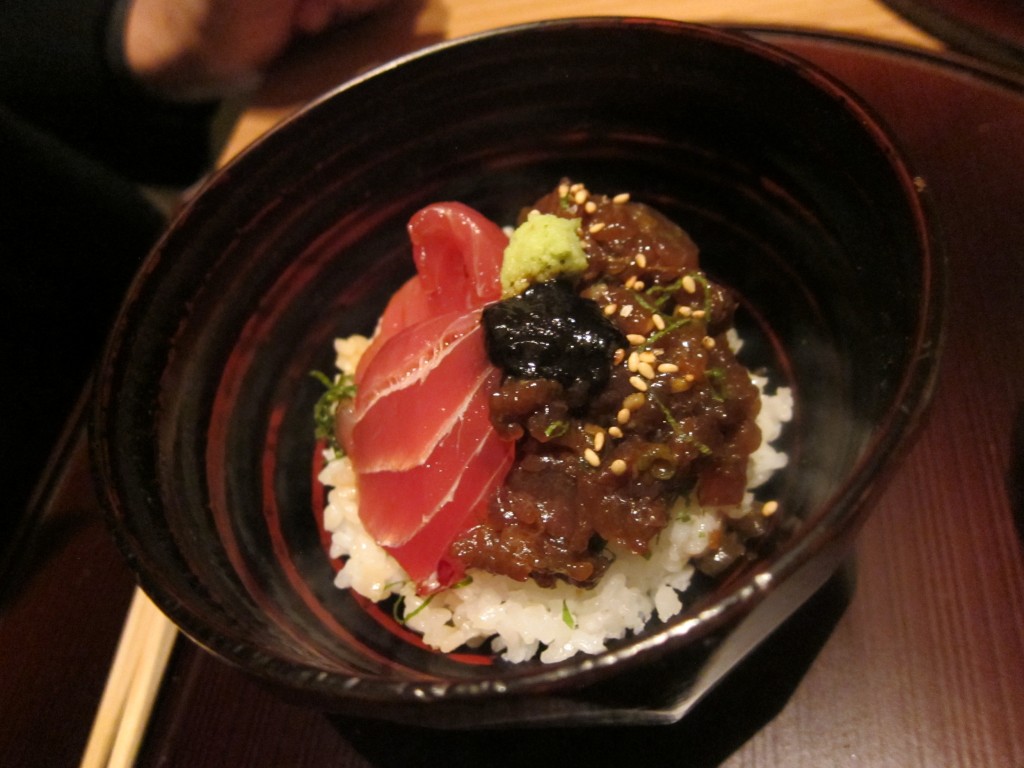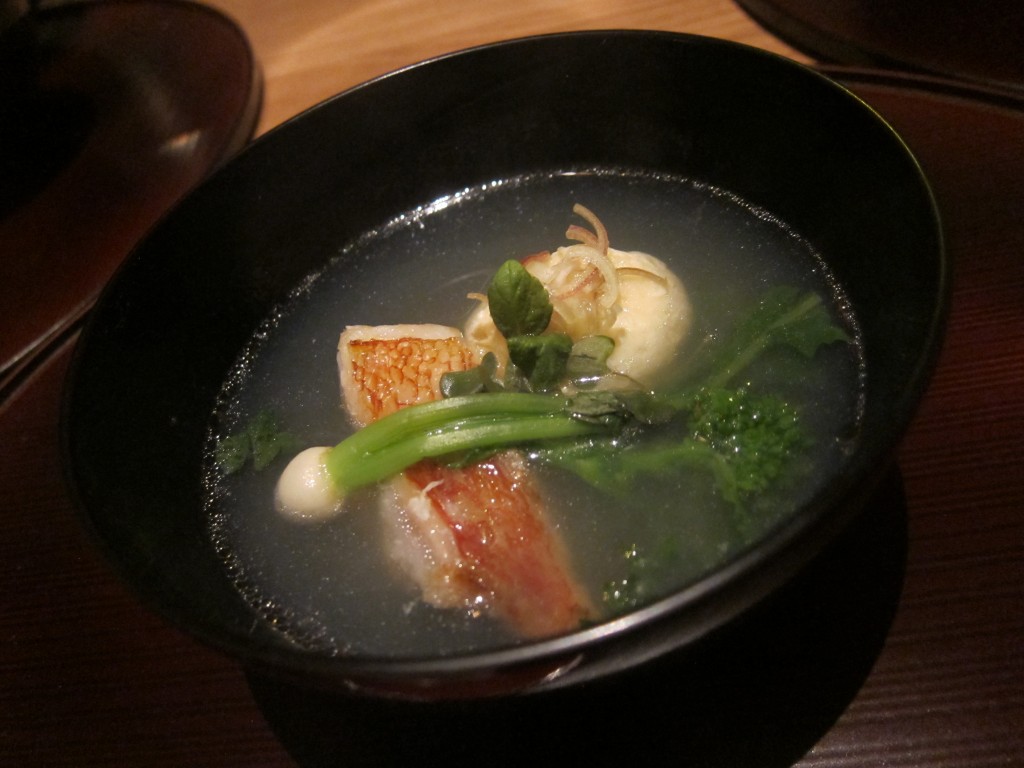In New York, the city that has pretty much seen it all, when one of the more intriguing restaurant concepts in recent memory finally opens its doors after three years in the works, important writing deadlines simply have to (temporarily) be damned.
After a long fascination with and love for Japanese food, David Bouley, the American restaurateur behind New York’s upscale French standard Bouley, finally dipped his spatula into the country’s culinary heritage in April, opening Brushstroke in TriBeCa, a collaboration with the Tsuji Culinary Institute in Osaka that was conceptualized as an homage to the cuisine. (The name is a nod to the artistry that goes into Japanese food presentation.)
We were curious to see what a French-inflected American chef and some of Japan’s best culinary instructors would cook up. So with great appetites, we closed our laptops and off we went …
Brushstroke feels distinctly Japanese from the start — its recycled wood-paneled walls, blond-wood dining counter and Japanese chefs industriously chopping away in full view conjure up thoughts of the country and its spare, elegant sensibility.
Look a little closer, however, and you’ll see touches of Bouley’s intense attention to detail as channeled through Super Potato, the Japanese interior design firm that has created spaces for noteworthy hotels all over Asia. The wood-covering that lines the walls of Brushstroke’s bar, for example, is made from 25,000 books stripped of color and mashed together to form a highly textured, striking collage.
Among these books, little stories are being told — a closer look at a series of tiny backlit boxes reveals dioramas representing scenes from daily life in Japan. One, for example, offers a window into a miniature Japanese eatery — a restaurant within Bouley’s restaurant.
If you’re sitting in the restaurant, the eight-course $85 set menu is your only option. (A la carte dishes are offered in the bar area.) The menu changes daily, based on seasonal ingredients. So with very little ado, the show began.
Our first course impressed us from the moment the waiter gently placed a curved wooden placemat bearing a Chinese peony in striking carmine on the table and began carefully arranging items on it. A cube of mountain yam tofu topped with a large dollop of sea urchin came swimming in a tomato water gelee, flanked with a side serving of little diced hearts of palm tossed with basil miso paste. The yam tofu had a beautifully creamy texture and none of the usual heaviness of starchy yam — it didn’t have as much taste as most house-made soy tofus, however, making it a rather bland beginning, even when paired with the salty sea urchin.
The hearts of palm, though intended as the side show, turned out to be the star of this platter. The basil miso packed an intense punch and the shower of rice cracker nubs that coated the hearts of palm offered a lovely crunch.
A slice of rockfish came paired with a scallop and dungeness crab dumpling in a salty Cherrystone clam dashi broth that had a slightly charred taste to it that was delightful. (In Chinese cooking, the “wok hei” — or wok heat — flavor is highly prized in many dishes. This broth had wok hei in spades.)
The rockfish was fine — if a little overcooked — but the dumpling was truly memorable. Each bite offered a delicious combination of scallop and crab, packed with flavor.
Up next, the chef’s selection of sashimi — the long island fluke (on the right) was OK on its own but far better jazzed up when drenched in the soy, daikon radish and scallion dipping sauce that accompanied it. We had no beef with the chunks of fatty tuna (left), however — firm yet creamy, it was delicious on its own, barely needing any wasabi or soy-vinegar sauce to prop it up.
Grilled Tasmanian trout (treated with a mustard marinade) came topped with juicy salmon roe and crushed pistachios on a bed of green apple puree encircled with a moat of red apple juice. The combination of flavors worked well here — I particularly liked the contrast between the more sour puree and the sweet juice, combined with the saltiness of roe and the caramelized char of the grilled fish.
Our trout, however, was far too cooked — an odd problem to have in a Japanese restaurant, the one place you would not think to have to ask a chef for not-so-well-done fish.
Because we were dining with a bold-faced name, rock star “Top Chef” Masters judge Gael Greene (who was spotted at this point because she wasn’t in disguise), an extra course emerged, courtesy of Bouley. Beautifully presented on a rustic ceramic plate that looked like an oyster shell itself, this Pacific jumbo oyster had been sliced into soft and intensely creamy chunks, placed on a soft nest of aonori seaweed and topped with diced green apples. The combination of salty and sweet — with a great contrast of crisp and milky mouthfeels — were nicely done here.
 Back on the set menu track, a seared lobster was done nicely — undercooked enough to seem like the bastard child of sashimi — and coated with creamy white miso. Razor clams that came soaked in the same white miso sauce and topped with sea urchin were just fine — though, in flavor, a poor step-sister to the lobster beside it.
Back on the set menu track, a seared lobster was done nicely — undercooked enough to seem like the bastard child of sashimi — and coated with creamy white miso. Razor clams that came soaked in the same white miso sauce and topped with sea urchin were just fine — though, in flavor, a poor step-sister to the lobster beside it.
Our fatty slices of very artfully arranged grilled duck breast smoked in sencha tea leaves were tender, moist and very nicely cooked. Its slight smokiness was just enough. But the accompaniment, once again, stole the show — in this case, eggplant that has been braised in dashi.
Now, I am not a fan of eggplant — but if eggplant always came like this, I would eat it every day. This morsel of eggplant was so juicy each bite practically oozed dashi flavor.
 At this point, we were starting to get tired. This dinner, though beautiful and perfectly enjoyable, had gone on for close to three hours by the time our entrees arrived.
At this point, we were starting to get tired. This dinner, though beautiful and perfectly enjoyable, had gone on for close to three hours by the time our entrees arrived.
The little bowls of rice that appeared made us determined to soldier on, however. This was the one course of the meal where we had a choice, so our dishes were varied. The sushi assortment was disappointingly pedestrian — and left half eaten. One small bowl came topped with a deep-fried tempura pancake of spring vegetables and lobster.
The chunks of lightly seasoned raw tuna served over rice (which cost an extra $8 as a meal option) was wonderful — both the seasoned and unseasoned tuna were delicious, even before mixing in the gob of salty, black nori seaweed sauce that came with it.
 We had been eagerly anticipating the lobster steamed with rice in a rustic pot (which cost $18 extra). And while it was, again, nicely presented and looked promising, the rice in the end turned out to be rather bland, even with the juicy globules of salmon roe mixed in.
We had been eagerly anticipating the lobster steamed with rice in a rustic pot (which cost $18 extra). And while it was, again, nicely presented and looked promising, the rice in the end turned out to be rather bland, even with the juicy globules of salmon roe mixed in.
 The meal ended on a bang, however. A small square of chocolate and adzuki (red bean) cake came coated with a ring of sweet soy powder and drizzled with kuromitsu (black honey) sauce. Our table was mixed on this — some thought it lacked flavor but as someone who’s not a big fan of super-sweet chocolate desserts, I thought the tastes were just right here.
The meal ended on a bang, however. A small square of chocolate and adzuki (red bean) cake came coated with a ring of sweet soy powder and drizzled with kuromitsu (black honey) sauce. Our table was mixed on this — some thought it lacked flavor but as someone who’s not a big fan of super-sweet chocolate desserts, I thought the tastes were just right here.
The soy milk panna cotta topped with matcha green tea sauce was outstanding, however — even before we dug deep and discovered the sweet adzuki beans lining the bottom of the bowl. The texture and taste of the panna cotta were perfect and the matcha added a lovely earthiness to the understated sweetness of the dessert.
 As a final treat, the waiter told us a story of Bouley going to the famed El Bulli in Spain and spending time with chef Ferran Adrià in the kitchen there. While Bouley was there, he said, Adria made Spanish wafer treats with him.
As a final treat, the waiter told us a story of Bouley going to the famed El Bulli in Spain and spending time with chef Ferran Adrià in the kitchen there. While Bouley was there, he said, Adria made Spanish wafer treats with him.
“It’s good to know Ferran never sleeps,” Gael said.
Back in New York, Bouley decided to try the technique using Japanese rice paper. His version involves filling sheets of rice paper with toasted pine nuts, brushing them with anise sugar and topping them with matcha powder (the green versions) and shiso powder (the purple ones).
While we liked the light crunchiness of these wafers, the tastes were a little jarring. The matcha version was fine but the shiso one with its biting and slightly bitter taste, brought on winces all around.
As mixed as our reviews were about the wafers, however, they looked incredibly beautiful, nestled just so in a gorgeous box. The dish summed up our overall brushstroke experience — some items are good, some are misses. But in the end, what you’ll remember the most is not likely to be the food but rather, how exquisite everything looked.
(This was, in fact, underscored by the lovely Japanese paper package, topped with a bow, that our lobster rice leftovers were swaddled in.)
If looks are all that matter, then Brushstroke is genius. But it’s nice, sometimes, if you can actually tell a book from its cover.
Brushstroke, 30 Hudson Street, New York, N.Y.; 212.791.3771.










